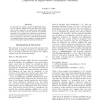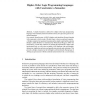1650 search results - page 3 / 330 » Information Modeling and Higher-order Types |
CADE
2006
Springer
14 years 6 months ago
2006
Springer
In this paper, we discuss a lightweight approach to eliminate the overhead due to implicit type arguments during higher-order unification of dependently-typed terms. First, we show...
ITP
2010
13 years 9 months ago
2010
Nitpick is a counterexample generator for Isabelle/HOL that builds on Kodkod, a SAT-based first-order relational model finder. Nitpick supports unbounded quantification, (co)ind...
KI
2008
Springer
13 years 5 months ago
2008
Springer
In this paper we suggest a typed compositional semantics for nominal compounds of the form [Adj Noun] that models adjectives as higher-order polymorphic functions, and where types...
TLCA
2007
Springer
13 years 12 months ago
2007
Springer
A Kripke Semantics is defined for a higher-order logic programming language with constraints, based on Church’s Theory of Types and a generic constraint formalism. Our syntactic...
POPL
1990
ACM
13 years 9 months ago
1990
ACM
Typed -calculus is an important tool in programming language research because it provides an extensible framework for studying language features both in isolation and in their rel...


